Search the Special Collections and Archives Portal
Search Results

Transcript of interview with Patricia Mulroy by Stefani Evans and Claytee D. White, January 03, 2017
Date
Archival Collection
Description
Patricia Mulroy served Las Vegas as the general manager of the Las Vegas Valley Water District from 1989 to 2014. She served the state of Nevada as the general manager of the Southern Nevada Water Authority from 1993 to 2014. Patricia helped to build the Authority, and saw the state through the devastating drought of the Colorado River. Patricia was born in Frankfurt, Germany on February 24, 1953. As a young girl, she lived in several different countries, but always felt that the United States was her home. Her experiences abroad fed her to develop a fascination with government work and state service. She arrived in Nevada in 1974 to attend UNLV. In 1989, Patricia became the general manager of the Las Vegas Valley Water District. She entered the field at a tumultuous time, facing the drought of the Colorado River and tension within the districts. She pioneered the Water Authority, which revolutionized Southern Nevada’s water rights system and allowed the districts to deal with the issue cooperatively. She worked with other Southwestern states and Mexico to support Las Vegas and Nevada through the drought. Patricia retired in 2014, but has chosen to remain active in politics and business. She is currently working with the World Bank in China on the World Economic Forum. She is also a nonresident Senior Fellow at the Brookings Institute, a faculty advisor for the Desert Research Institute, and a board member of the Wynn Board of Directors.
Text

James L. Hogan interview, March 11, 1978: transcript
Date
Archival Collection
Description
On March 11, 1978, collector Patty L. Baratti interviewed James Hogan (born April 6th, 1909 in Winton Place, Ohio) at his home in Las Vegas, Nevada. In this interview, Hogan talks about his time working with the telephone company in Arizona and moving to Las Vegas, Nevada. He discusses his time working on grazing rights and cattle ranching in Nevada and how planning went to ensure that farms were able to have land to graze their animals. He speaks about dealing with farmers, corporations, and the government and the frustrations he had to deal with before there were set laws about grazing. He also discusses the change from mainly family farms in Nevada to corporations owning much of the farmland.
Text
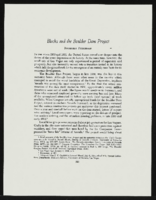
"Blacks and the Boulder Dam Project": manuscript by Roosevelt Fitzgerald
Date
Archival Collection
Description
From the Roosevelt Fitzgerald Professional Papers (MS-01082) -- Unpublished manuscripts file. Published manuscript, Nevada Historical Society.
Text
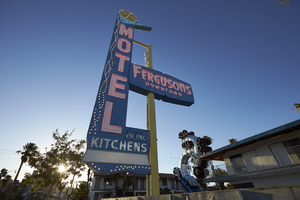
Photographs of Fergusons Motel sign at sundown, Las Vegas (Nev.), June 28, 2017
Date
Archival Collection
Description
Site address: 1028 Fremont St
Sign owner: 1028 Fremont LLC (Assessor) /Downtown Las Vegas Project (Bruzda, 2016; Millward, 2017; Schoenmann, 2013; Snel 2014)
Sign details: The building was constructed in 1946 (Assessor). The business opened originally as the Franklin Motel (RoadsideArchitecure.com). The motel may have been renamed Ferguson's in 1962 (Las Vegas motels-Then and Now). The current sign probably dates from the late 1950's or 1960's and is not from the Franklin (RoadsideArchitecture.com). Downtown Project partners purchased Fergusons Motel in December 2012 and the property was closed as of 2013 (Schoennmann, 2013). The Downtown Project planned to convert the motel's 69 rooms into retail shops, offices, taverns and a restaurant (Schoenmann). As of May 2017, no construction had been completed and The Downtown Project had altered its plans to instead use the site for residences, restaurants and art space (Millward, 2017).
Sign condition: Condition is 5. The sign has been reconditioned to look like new.
Sign form: Pole
Sign-specific description: The sign is mounted on a rectangular metal pole which is painted yellow. Attached to the street side of the pole are several metal cabinets joined to form an "L" shape which points toward the motel. The bottom cabinet contains the word "KITCHENS", which runs horizontally in white painted sans serif letters and white sans serif skeleton neon letters. Below "KITCHENS" is a white plastic light box. Below the lightbox are two rows of intertwining clear light bulbs. The bottom of the metal cabinet is shaped like two undulating waves. Over the top of "KITCHENS" is a small cabinet which spells out "VACANCY" in white san serif letters which are covered by clear skeleton neon sans serif letters spelling out, "Sorry NO VACANCY". The word "MOTEL" runs vertically down the sign in white painted and white neon letters, all san serif. Neon tubes outline the letters while another tube runs down the center. Running down the street side of the sign are three intertwining rows of clear light bulbs. The top of the cabinet is painted green in the shape of a chevron or boomerang. The bottom sides of the boomerang intersect at a perpendicular angle and the top is curved. The tip of the boomerang juts out from the sign toward the hotel. The interior of the boomerang is traced by three rows of skeleton neon. On top of the boomerang is a yellow circle outlined in light blue. The blue outline contains 16 clear light bulbs. The yellow interior of the circle has 16 spiral rows of clear light bulbs running from the exterior to the interior of the circle. The yellow pole which supports the sign runs through a lozenge shaped blue metal cabinet. The cabinet states, "FERGUSONS" in Googie style white letters and skeleton neon and "DOWNTOWN" is sans serif white letters and skeleton neon. Above the cabinet, attached to a pole, is a white statue of a climbing figure which is similar to other figures on Fremont Street and was likely added to the sign by the Downtown Project.
Sign - type of display: Neon and incandescent
Sign - media: Steel and plastic. Possibly fiberglass for the climbing figure.
Sign - non-neon treatments: Incandescent light bulbs, light box
Sign environment: In the East Fremont district this motel is surrounded by other motels many of which are also currently closed.
Sign - date of installation: Circa late 1950's/ 1960's
Sign - date of redesign/move: The sign is probably from the late 1950's or 1960's (RoadsideArchitecture.com). A postcard from the 1960's shows the background of the "MOTEL" portion of the sign painted black (Garofalo, 2011). Below "FERGUSONS" hung two smaller signs: the top sign displayed the AAA symbol and the words, "Phone", "Pool" and "T-V" (Garofalo, 2011). The lower sign displayed three badges (auto clubs?).
Sign - artistic significance: The sign design style is Googie.
Survey - research locations: Bruzda, N. (2016 May 2). Construction planned for Fergusons Motel in downtown Las Vegas still yet to be seen. Las Vegas Review Journal. Retrieved from https://www.reviewjournal.com/business/construction-planned-for-fergusons-motel-in-downtown-las-vegas-still-yet-to-be-seen/ Clark County Assessor. Parcel No. 139-35-201-006. Retrieved from http://www.clarkcountynv.gov/assessor/Pages/PropertyRecords.aspx?H=redrock&P=assrrealprop/pcl.aspx Garofalo, M. (2011 November 1). Still standing-Fergusons[sic] Motel [Photograph]. Retrieved from https://www.flickr.com/photos/vintageroadtrip/6305057708/in/photolist-aBa4Zw-qeNAZa-fxWx3V-54q1dr-7qs1A1-81uYMJ-9i1MAF-pUfCjM-m57jkW-8BzGrN-nM1Nyq-zCCx9s-EJBciL-BkTrgS-zpiF94-aW6aKv-2ZFRQ4-opLfq5-riESKk-n8Wdz-qmMWgN-riESNg-FW15N3-dvx2N-7As5GF-aC7z44-omUMSx-qmMWKy-5XLHvx-evbtLo-onbi7i-635ftN-UhMyz7-8sfVoW-BVWgRY-m8qWB8-ev8mFD-6sadvS-8FdMPf-pBdbtQ-etP68R-pfCeRE-54HNiA-9uFAxg-3b4UbW-FWTWBt-pjCShX-8Bv6mp-aUDgVc-qUKBLu Las Vegas motels-Then and now. (n.d.) Retrieved from http://stefanidrivesvegas.com/2.html Millward, W. T. (2017 May 8). Plans to turn Fergusons Motel into mixed-use campus advance. Las Vegas Review Journal. Retrieved from https://www.reviewjournal.com/local/local-las-vegas/downtown/plans-to-turn-fergusons-motel-into-mixed-use-campus-advance/ RoadsideArchitecture.com. Fergusons Motel. Retrieved from http://www.roadarch.com/signs/nvvegas2.html Schoenmann, J. (2013 July 3). Joe Downtown: Ferguson Motel being converted into taverns, retail spaces. Las Vegas Sun. Retrieved from https://lasvegassun.com/news/2013/jul/03/joe-downtown-ferguson-motel-being-converted-tavern/ Snel, A. (2014 August 5). New plans proposed for rundown Fremont Street motel. Las Vegas Review Journal. Retrieved from https://www.reviewjournal.com/business/new-plans-proposed-for-rundown-fremont-street-motel/
Surveyor: Mitchell Cohen
Survey - date completed: 2017-08-16
Sign keywords: Steel; Plastic; Fiberglass; Incandescent; Pole sign; Neon
Mixed Content
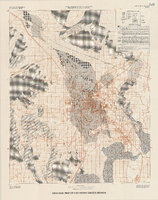
Geologic map of Las Vegas Valley, Nevada, 1982
Date
Description
Image
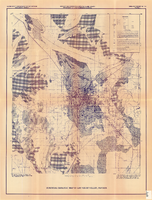
Surficial geologic map of Las Vegas Valley, Nevada, circa 1981
Date
Description
Image
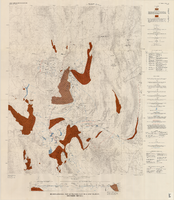
Hydrogeologic map of Nevada Test Site and vicinity, southern Nevada, 1965
Date
Description
Image
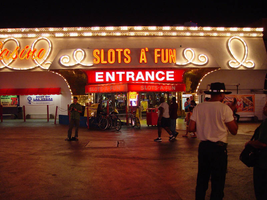
Photographs of Slots a Fun signs, Las Vegas (Nev.), 2002
Date
Archival Collection
Description
Site address: 2880 S Las Vegas Blvd
Sign owner: Mandalay Resort Group
Sign details: Slots a' Fun is located on the south side of the Circus Circus parking lot, but it is on residence now. The small building stretches west with the mouth of the building being an open mouth facing the east. The external signage is located on the elongated north face of the building, and the gaping east entrance. The north side is comprised of gold painted, crafted raceways with various text signage. The entrance is adorned with various internally lit cabinets as well as a marquee adorned pediment, located within the front face of the entrances overhang. The entrance is considerably small, sandwiched between flamboyant properties such as the Westward Ho and the Circus Circus.
Sign condition: Structure 4 Surface 4 Lighting 4 The structural integrity is good as well the lighting. The surface is starting to show some signs of wear, but not very much at all.
Sign form: Fascia
Sign-specific description: The main entrance faces east and contains an interesting array of signage. The front is highlighted by two giant pillars. The are uniquely designed as inverted, tapered cones supporting the barrel vaulted cantilevered overhang. Near the top portion of the column a backlit message box cuts through the pole dividing it into two apparent sections. Bordered on all edges with gold polished raceways with incandescent bulbs, the box is animated in a chasing pattern. A top the poles on the north and south sides a polished aluminum, circular cabinet, has red, backlit plastic containing the words "Slots A' Fun" in white text. These cabinets are outlined in red neon. The edges of the apparent recess are lined with incandescent bulbs Each vault contains a long bank of large incandescent sphere's, arranged in single file. Along the front of the cantilevered overhang we have an entablature running the length of building. Gold raceways run horizontally along the top and the bottom with rows of triple incandescent bulbs. In the center of the pediment, white channel letters painted red on the inside, with incandescent bulbs filling the interior space of all of the characters. Each letter is also outlined in neon. The rest of the interior space of the facade is sculpted raised circular pattern with incandescent bulbs placed in the centers where the repeated panels connect. Under that, a polished gold aluminum banner with various assorted neon letters and advertisements is displayed. Since the "Slots A' Fun" used to be part of the Circus Circus it is closely integrated into the environment and even with the signage. Upon the northeast corner of the building a sign for the Circus Circus is perched on the top of the roofline facing north/south. Facade is sculpted raised circular pattern with incandescent bulbs placed in the centers where the repeated panels connect. Moving around to the north face of the building, an array of signage is present headed west along the wall. Along the stucco facade we have overhangs of different dimensions. On these three overhangs we have gold channels in the shape of a continuous curly cue or rope shape. These raceway channels are lined on the inside with incandescent bulbs. The first one, furthest east, is a good length, and smaller in height than the others. The pattern loops eight times along the front. One single loop of the rope shape is located on the return width of the overhang as well. No text is incorporated with this overhang. The second curling raceway is over a wider, shallower depth. The overhang, is much larger in size and supports cursive pan channel letters painted red and outlined with red neon. The letters spell "Casino" in a continuous script text. The third overhang is the largest of the trio, and serves as the main entrance for this face of the building. It is in direct proximity to the actual Circus Circus building and the blazing signage, and porte cochere. This overhang is lower to the ground than the other two but projects further out. Channel letters spell "Slots A' Fun" in the front face of the overhang located in the center. The channel letters are painted red and lined on the interiors with red neon as well. This text is block instead of script. Flanking either side of the text there is the curling channels. The face of the building rises upward from the ground and meets the bottom edge of the overhang, with a continuous radius vault. The surface of the wall is surfaced with a gold reflective material. Just below the text of the overhang is a red steel cabinet, that is internally lit. The red painted steel box has a red plastic with a red plastic face with white lettering. The block text reads "Entrance." The sides are sculpted with a radius space reduced out of the sides of the cabinet. The edges of the face are lined with incandescent bulbs. Below the cabinet a red, vinyl, awning extends out over the doors, and a pedestrian path. A small portion of the main structure still extends west with one more loop on the face of the building.
Sign - type of display: Neon; Incandescent; Backlit
Sign - media: Steel; Masonry
Sign - non-neon treatments: Graphics; Paint
Sign animation: Chasing, oscillating
Notes: All of the raceways chase each other. This includes all of the different aspects which are lined with incandescent bulbs.
Sign environment: The Slots A Fun has the unique position of being in between the Westward Ho and the Circus Circus. It was at one time part of the Circus Circus, so it essentially blends in with its environment. The south side of the building literally resides touching the Westward Ho.
Sign manufacturer: YESCO
Sign - thematic influences: The theme of Slots a Fun can be regarded as the heavy influence from its initial design based on the Circus Circus. In that respect it would be linked to a circus theme. The almost surrealistic swelling of the tile laden columns on the east face of the building as well as the curly cue raceways suggest a busy excitement usually associated with the extravaganza of the circus. To that end, the interaction with the Las Vegas environment would suggest the theme of a party. Such influence of the same element of theming can be seen in the umbrella shapes and chasing action of the neighboring Westward Ho. Several elements of the facade suggest different trends as well. The eastern overhang's vaulted dome is surfaced with the highly reflective polished gold aluminum. The entrance on the northern face incorporated with the surfacing with a golden reflective surface. The trend of using the reflective surface to further perpetuate the luminescence is used highly in the flanking properties. The use of the raceways is a unique function, not repeated on any other property.
Sign - artistic significance: Some unusual elements that have not been repeated can be found in this lesser-known example of sign art.
Surveyor: Joshua Cannaday
Survey - date completed: 2002
Sign keywords: Chasing; Oscillating; Fascia; Neon; Incandescent; Backlit; Steel; Masonry; Graphics; Paint
Mixed Content
